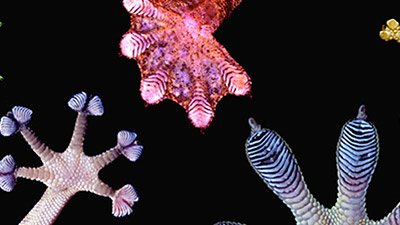Marine Animal Robots
National Geographic News: “Animal Robots: Marine Machines Made in Nature’s Image” Are a series of robots made in nature’s image, or were they inspired by God’s designs? Or could it be both?
National Geographic News offers a gallery of robotic creations that are based on marine animals. Among the designs are “robo-lobsters,” “AquaPenguins,” and even “Charlie the Robo-Tuna.” The full list of robots shown, along with their natural inspirations and intended purposes, is:
- Gymnobot, inspired by Amazonian knifefish—designed to study marine life.
- A robotic fish, inspired by carp—designed to search for pollutants.
- Robo-lobsters, inspired by, well, lobsters—designed to locate underwater mines.
- AquaPenguins, inspired by penguins—designed to test new technologies for German engineering firm Festo.
- Charlie the Robo-Tuna, the original version and the latest version, inspired by tuna—designed to with nearly 3,000 parts to “mimic real fish as closely as possible.”
- AquaJelly robots, inspired by jellyfish—designed to swim in formation with their kin, communicating with infrared LEDs.
- Kinshachi, inspired by a mythological Japanese creature with the head of a tiger and the body of a fish—designed to monitor the safety of bridges and observe fishing conditions.
Even when human designs mimic nature, nature often wins out.
The National Geographic News report notes, “Researchers worldwide are developing robots that look and act like aquatic creatures [. . .] because biomimetic gadgets—bots that take inspiration from nature—are often more efficient than their clunkier [i.e., human-made] counterparts.” Even when human designs mimic nature, nature often wins out: for example, the modern version of Charlie the Robo-Tuna still swims only a tenth as fast as its bona fide, living “cousin.”
Human engineers have accomplished great feats of design, from airplanes to computers to bridges and beyond. But what does it tell us about the original Creator when the best we can do is to emulate His creations—and even then, only imperfectly? And how rational is it to know that biomimetic robots are intelligently designed by humans, but to believe that the almost infinitely more complex and well-designed living creatures (which served as models for the scientists) came into existence by the blind, purposeless, directionless process of time, chance, and the laws of nature?
For more information:
Remember, if you see a news story that might merit some attention, let us know about it! (Note: if the story originates from the Associated Press, Fox News, MSNBC, the New York Times, or another major national media outlet, we will most likely have already heard about it.) And thanks to all of our readers who have submitted great news tips to us.
(Please note that links will take you directly to the source. Answers in Genesis is not responsible for content on the websites to which we refer. For more information, please see our Privacy Policy.)
Recommended Resources

Answers in Genesis is an apologetics ministry, dedicated to helping Christians defend their faith and proclaim the good news of Jesus Christ.
- Customer Service 800.778.3390
- © 2024 Answers in Genesis







